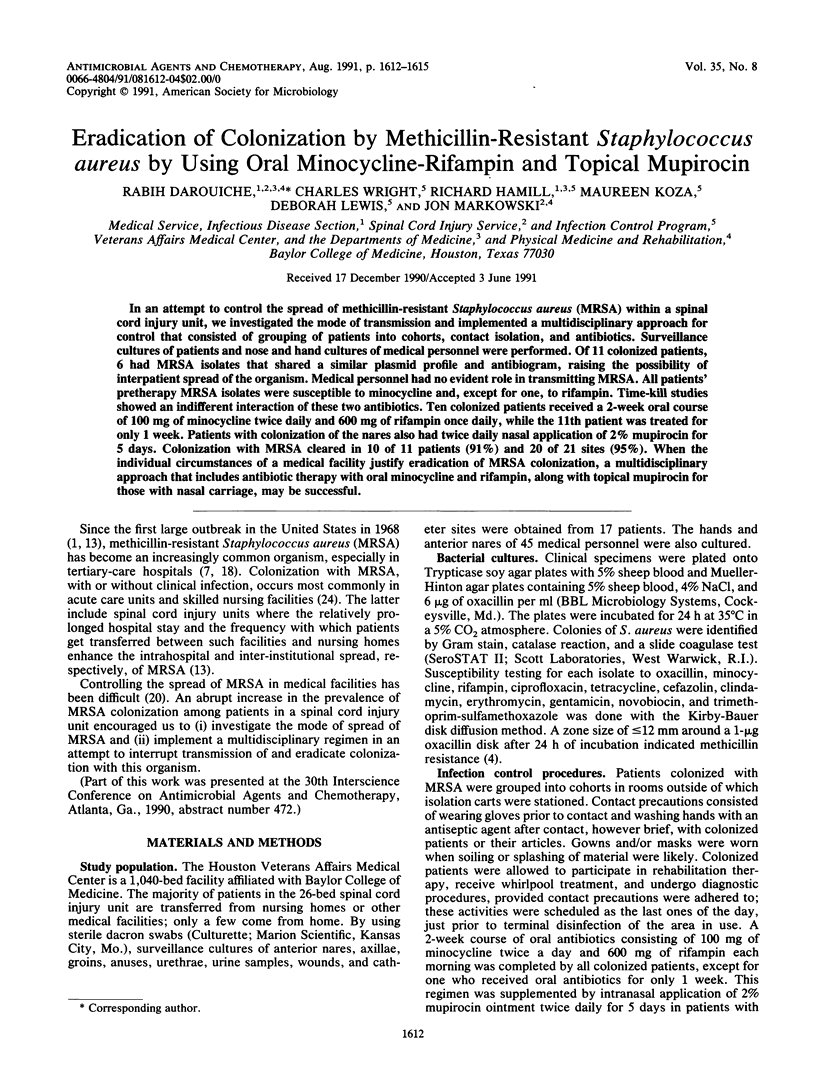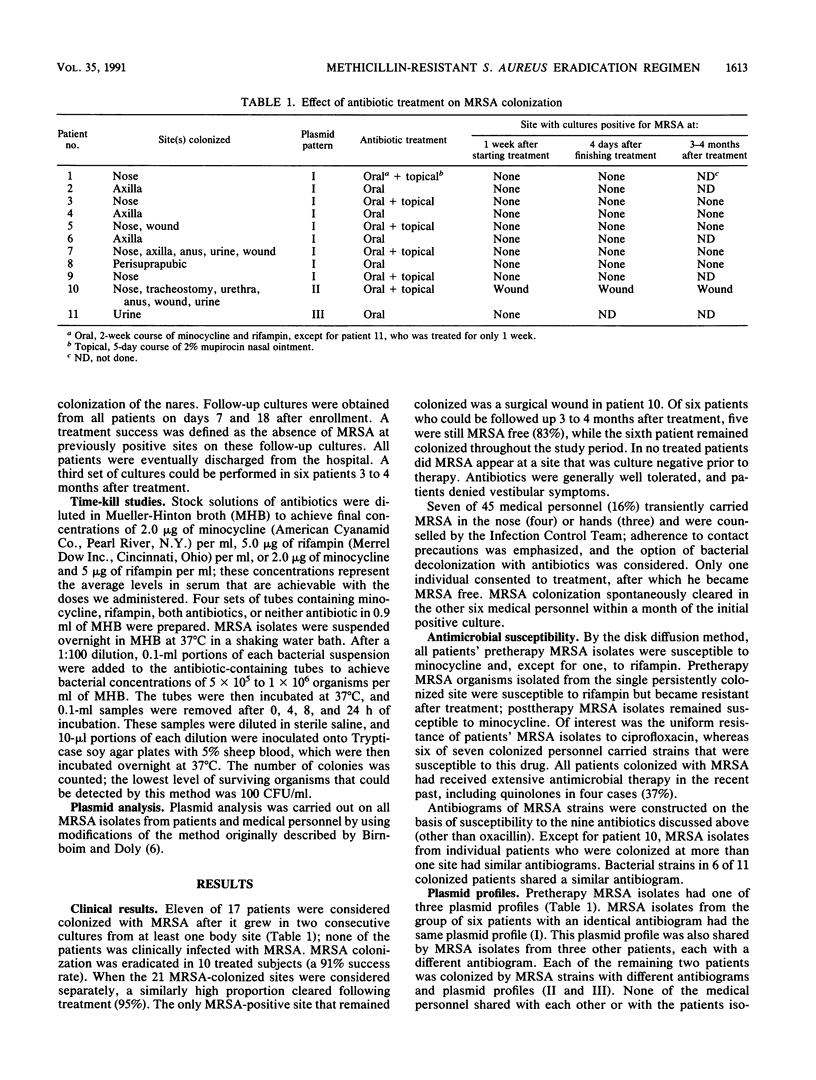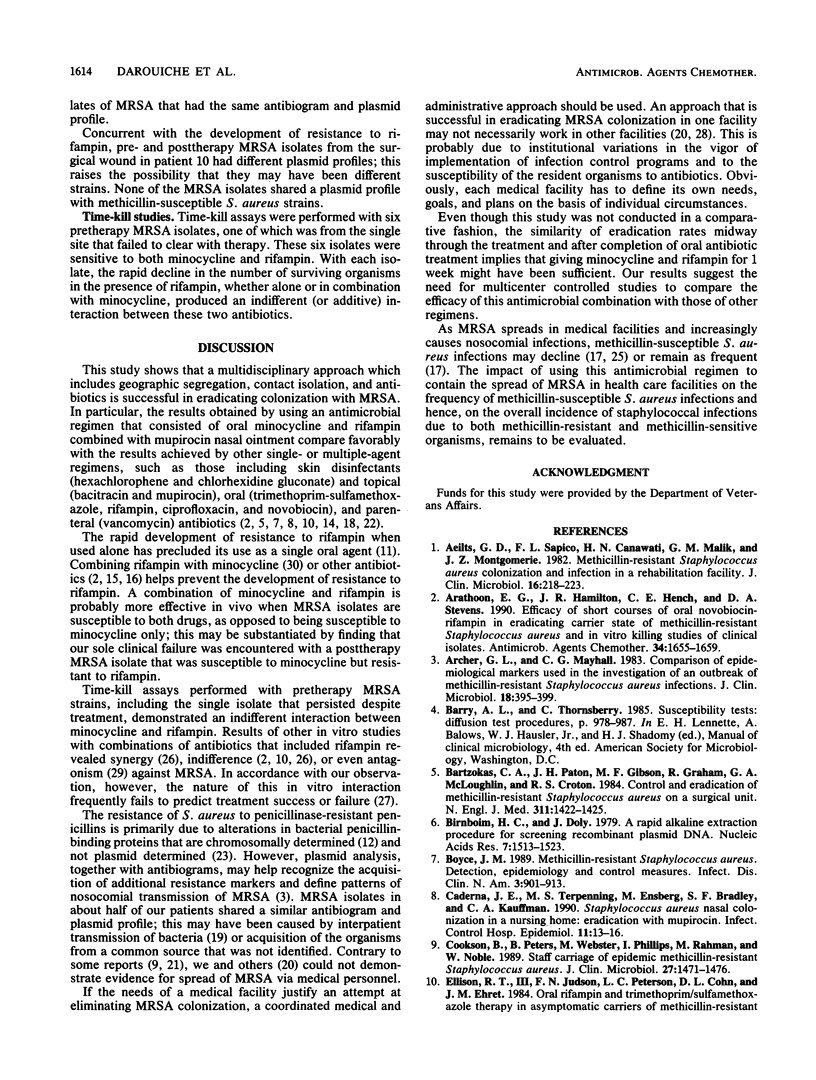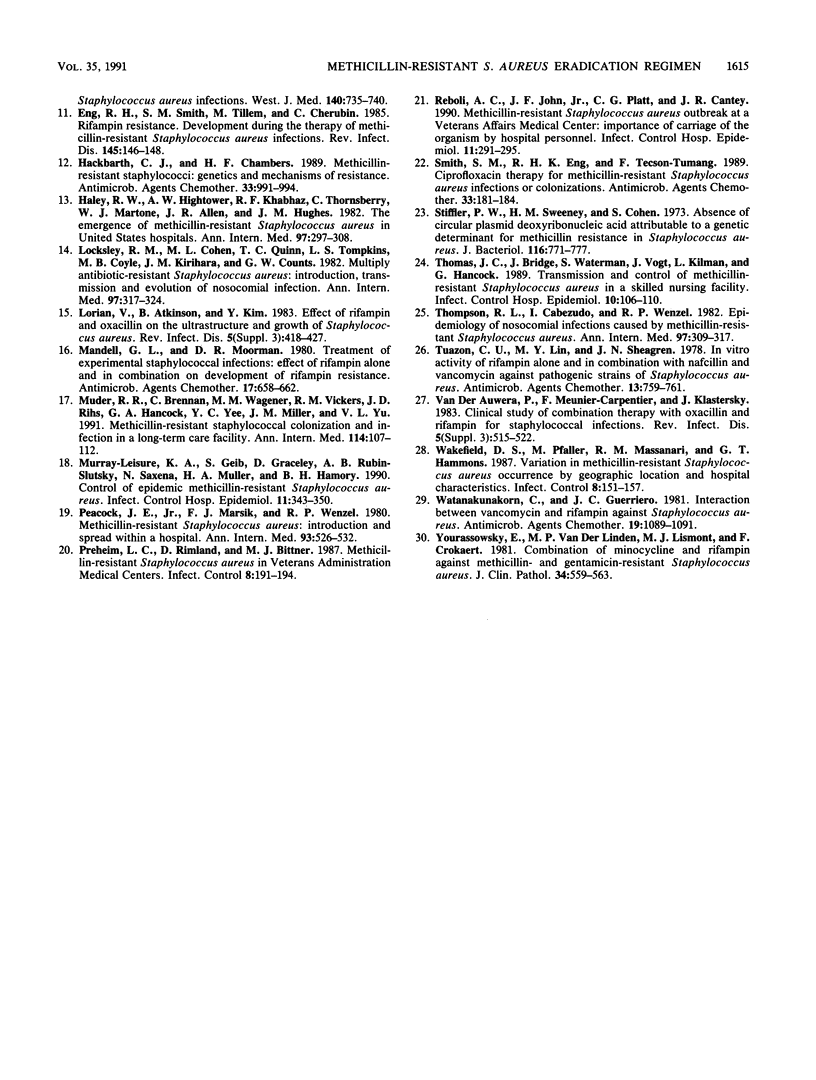Abstract
In an attempt to control the spread of methicillin-resistant Staphylococcus aureus (MRSA) within a spinal cord injury unit, we investigated the mode of transmission and implemented a multidisciplinary approach for control that consisted of grouping of patients into cohorts, contact isolation, and antibiotics. Surveillance cultures of patients and nose and hand cultures of medical personnel were performed. Of 11 colonized patients, 6 had MRSA isolates that shared a similar plasmid profile and antibiogram, raising the possibility of interpatient spread of the organism. Medical personnel had no evident role in transmitting MRSA. All patients' pretherapy MRSA isolates were susceptible to minocycline and, except for one, to rifampin. Time-kill studies showed an indifferent interaction of these two antibiotics. Ten colonized patients received a 2-week oral course of 100 mg of minocycline twice daily and 600 mg of rifampin once daily, while the 11th patient was treated for only 1 week. Patients with colonization of the nares also had twice daily nasal application of 2% mupirocin for 5 days. Colonization with MRSA cleared in 10 of 11 patients (91%) and 20 of 21 sites (95%). When the individual circumstances of a medical facility justify eradication of MRSA colonization, a multidisciplinary approach that includes antibiotic therapy with oral minocycline and rifampin, along with topical mupirocin for those with nasal carriage, may be successful.
Full text
PDF



Selected References
These references are in PubMed. This may not be the complete list of references from this article.
- Aeilts G. D., Sapico F. L., Canawati H. N., Malik G. M., Montgomerie J. Z. Methicillin-resistant-Staphylococcus aureus colonization and infection in a rehabilitation facility. J Clin Microbiol. 1982 Aug;16(2):218–223. doi: 10.1128/jcm.16.2.218-223.1982. [DOI] [PMC free article] [PubMed] [Google Scholar]
- Arathoon E. G., Hamilton J. R., Hench C. E., Stevens D. A. Efficacy of short courses of oral novobiocin-rifampin in eradicating carrier state of methicillin-resistant Staphylococcus aureus and in vitro killing studies of clinical isolates. Antimicrob Agents Chemother. 1990 Sep;34(9):1655–1659. doi: 10.1128/aac.34.9.1655. [DOI] [PMC free article] [PubMed] [Google Scholar]
- Archer G. L., Mayhall C. G. Comparison of epidemiological markers used in the investigation of an outbreak of methicillin-resistant Staphylococcus aureus infections. J Clin Microbiol. 1983 Aug;18(2):395–399. doi: 10.1128/jcm.18.2.395-399.1983. [DOI] [PMC free article] [PubMed] [Google Scholar]
- Bartzokas C. A., Paton J. H., Gibson M. F., Graham F., McLoughlin G. A., Croton R. S. Control and eradication of methicillin-resistant Staphylococcus aureus on a surgical unit. N Engl J Med. 1984 Nov 29;311(22):1422–1425. doi: 10.1056/NEJM198411293112207. [DOI] [PubMed] [Google Scholar]
- Birnboim H. C., Doly J. A rapid alkaline extraction procedure for screening recombinant plasmid DNA. Nucleic Acids Res. 1979 Nov 24;7(6):1513–1523. doi: 10.1093/nar/7.6.1513. [DOI] [PMC free article] [PubMed] [Google Scholar]
- Boyce J. M. Methicillin-resistant Staphylococcus aureus. Detection, epidemiology, and control measures. Infect Dis Clin North Am. 1989 Dec;3(4):901–913. [PubMed] [Google Scholar]
- Cederna J. E., Terpenning M. S., Ensberg M., Bradley S. F., Kauffman C. A. Staphylococcus aureus nasal colonization in a nursing home: eradication with mupirocin. Infect Control Hosp Epidemiol. 1990 Jan;11(1):13–16. doi: 10.1086/646072. [DOI] [PubMed] [Google Scholar]
- Cookson B., Peters B., Webster M., Phillips I., Rahman M., Noble W. Staff carriage of epidemic methicillin-resistant Staphylococcus aureus. J Clin Microbiol. 1989 Jul;27(7):1471–1476. doi: 10.1128/jcm.27.7.1471-1476.1989. [DOI] [PMC free article] [PubMed] [Google Scholar]
- Eng R. H., Smith S. M., Tillem M., Cherubin C. Rifampin resistance. Development during the therapy of methicillin-resistant Staphylococcus aureus infection. Arch Intern Med. 1985 Jan;145(1):146–148. doi: 10.1001/archinte.145.1.146. [DOI] [PubMed] [Google Scholar]
- Hackbarth C. J., Chambers H. F. Methicillin-resistant staphylococci: genetics and mechanisms of resistance. Antimicrob Agents Chemother. 1989 Jul;33(7):991–994. doi: 10.1128/aac.33.7.991. [DOI] [PMC free article] [PubMed] [Google Scholar]
- Haley R. W., Hightower A. W., Khabbaz R. F., Thornsberry C., Martone W. J., Allen J. R., Hughes J. M. The emergence of methicillin-resistant Staphylococcus aureus infections in United States hospitals. Possible role of the house staff-patient transfer circuit. Ann Intern Med. 1982 Sep;97(3):297–308. doi: 10.7326/0003-4819-97-3-297. [DOI] [PubMed] [Google Scholar]
- Locksley R. M., Cohen M. L., Quinn T. C., Tompkins L. S., Coyle M. B., Kirihara J. M., Counts G. W. Multiply antibiotic-resistant Staphylococcus aureus: introduction, transmission, and evolution of nosocomial infection. Ann Intern Med. 1982 Sep;97(3):317–324. doi: 10.7326/0003-4819-97-3-317. [DOI] [PubMed] [Google Scholar]
- Mandell G. L., Moorman D. R. Treatment of experimental staphylococcal infections: effect of rifampin alone and in combination on development of rifampin resistance. Antimicrob Agents Chemother. 1980 Apr;17(4):658–662. doi: 10.1128/aac.17.4.658. [DOI] [PMC free article] [PubMed] [Google Scholar]
- Muder R. R., Brennen C., Wagener M. M., Vickers R. M., Rihs J. D., Hancock G. A., Yee Y. C., Miller J. M., Yu V. L. Methicillin-resistant staphylococcal colonization and infection in a long-term care facility. Ann Intern Med. 1991 Jan 15;114(2):107–112. doi: 10.7326/0003-4819-114-2-1-107. [DOI] [PubMed] [Google Scholar]
- Murray-Leisure K. A., Geib S., Graceley D., Rubin-Slutsky A. B., Saxena N., Muller H. A., Hamory B. H. Control of epidemic methicillin-resistant Staphylococcus aureus. Infect Control Hosp Epidemiol. 1990 Jul;11(7):343–350. doi: 10.1086/646185. [DOI] [PubMed] [Google Scholar]
- Peacock J. E., Jr, Marsik F. J., Wenzel R. P. Methicillin-resistant Staphylococcus aureus: introduction and spread within a hospital. Ann Intern Med. 1980 Oct;93(4):526–532. doi: 10.7326/0003-4819-93-4-526. [DOI] [PubMed] [Google Scholar]
- Preheim L. C., Rimland D., Bittner M. J. Methicillin-resistant Staphylococcus aureus in Veterans Administration Medical Centers. Infect Control. 1987 May;8(5):191–194. doi: 10.1017/s0195941700065929. [DOI] [PubMed] [Google Scholar]
- Reboli A. C., John J. F., Jr, Platt C. G., Cantey J. R. Methicillin-resistant Staphylococcus aureus outbreak at a Veterans' Affairs Medical Center: importance of carriage of the organism by hospital personnel. Infect Control Hosp Epidemiol. 1990 Jun;11(6):291–296. doi: 10.1086/646174. [DOI] [PubMed] [Google Scholar]
- Smith S. M., Eng R. H., Tecson-Tumang F. Ciprofloxacin therapy for methicillin-resistant Staphylococcus aureus infections or colonizations. Antimicrob Agents Chemother. 1989 Feb;33(2):181–184. doi: 10.1128/aac.33.2.181. [DOI] [PMC free article] [PubMed] [Google Scholar]
- Stiffler P. W., Sweeney H. M., Cohen S. Absence of circular plasmid deoxyribonucleic acid attributable to a genetic determinant for methicillin resistance in Staphylococcus aureus. J Bacteriol. 1973 Nov;116(2):771–777. doi: 10.1128/jb.116.2.771-777.1973. [DOI] [PMC free article] [PubMed] [Google Scholar]
- Thomas J. C., Bridge J., Waterman S., Vogt J., Kilman L., Hancock G. Transmission and control of methicillin-resistant Staphylococcus aureus in a skilled nursing facility. Infect Control Hosp Epidemiol. 1989 Mar;10(3):106–110. doi: 10.1086/645976. [DOI] [PubMed] [Google Scholar]
- Thompson R. L., Cabezudo I., Wenzel R. P. Epidemiology of nosocomial infections caused by methicillin-resistant Staphylococcus aureus. Ann Intern Med. 1982 Sep;97(3):309–317. doi: 10.7326/0003-4819-97-3-309. [DOI] [PubMed] [Google Scholar]
- Tuazon C. U., Lin M. Y., Sheagren J. N. In vitro activity of rifampin alone and in combination with nafcillin and Vancomycin against pathogenic strains of Staphylococcus aureus. Antimicrob Agents Chemother. 1978 May;13(5):759–761. doi: 10.1128/aac.13.5.759. [DOI] [PMC free article] [PubMed] [Google Scholar]
- Wakefield D. S., Pfaller M., Massanari R. M., Hammons G. T. Variation in methicillin-resistant Staphylococcus aureus occurrence by geographic location and hospital characteristics. Infect Control. 1987 Apr;8(4):151–157. doi: 10.1017/s0195941700065814. [DOI] [PubMed] [Google Scholar]
- Watanakunakorn C., Guerriero J. C. Interaction between vancomycin and rifampin against Staphylococcus aureus. Antimicrob Agents Chemother. 1981 Jun;19(6):1089–1091. doi: 10.1128/aac.19.6.1089. [DOI] [PMC free article] [PubMed] [Google Scholar]
- Yourassowsky E., van der Linden M. P., Lismont M. J., Crokaert F. Combination of minocycline and rifampicin against methicillin- and gentamicin-resistant Staphylococcus aureus. J Clin Pathol. 1981 May;34(5):559–563. doi: 10.1136/jcp.34.5.559. [DOI] [PMC free article] [PubMed] [Google Scholar]


